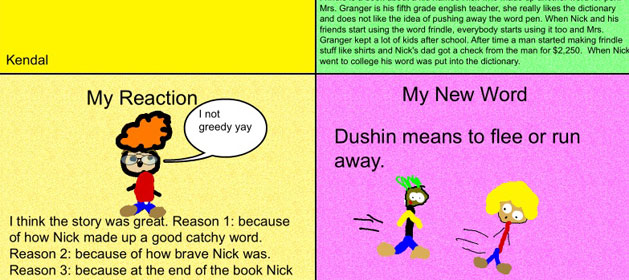
Help students listen to their inner voice and dig deeper to connect to text.

Educators across the country are grappling with the Common Core State Standards and what they mean for our students. I know that I am, even as a veteran elementary teacher of 28 years!
This year, I have a class consisting primarily of third graders. According to the common core standards, third graders should be able to:
Even at the third grade level, readers need to be able to do more than simply search text for specific answers. My students are learning to dig deeper, to make inferences, and paying attention to their “inner voice” as they read silently, take notes, and then form opinions on what they have read.
Two of my guided reading groups have been reading the book Frindle, by Andrew Clements. This novel is the story of Nick, a fifth grader who gets into trouble on the first day of class with the strict Mrs. Granger. As punishment, Nick is required to write a report on the origin of words.
As Nick works on the assignment, he wonders why he can't make up words of his own. Nick decides to refer to his pen as a “frindle,” much to Mrs. Granger's chagrin. Despite her efforts, the use of “frindle” spreads throughout the fifth grade, eventually making its way around the world.

I am fortunate to be able to work at PRIDE Academy, a technology-rich school in Santee, California. My students all have iPads that they work on throughout the day.
After students read the first few paragraphs of a chapter, they meet with me with their books and iPads. I model listening to your inner voice, sharing with my students my thoughts:
“Mrs. Deaver is crazy! I cannot believe any teacher would think that it is creative and cute for a student to turn the thermostat up. For Pete's sake! She teaches the hula to some students, while others are playing volleyball with a net made up of shirts! No wonder the principal was mad! Could you imagine Mrs. Southcott walking in on that scene?”
I show my students how to pay attention to the connections, inferences, and opinions they are thinking as they read a text. I then model how to write down those impressions into Evernote, an app we use for drafting essays and stories.
Each student has a notebook in Evernote, and they follow my lead by creating a note entitled “Frindle.” As students read each chapter, they add a new section to their note, subtitled with the chapter name, and record their impressions, opinions, and reactions to what they read.
The next day, students share what they thought about the chapter. We read a little of the next chapter, and then students repeat the process. I can use students' notes to see their reaction to what they're reading, and their impressions and opinions allow me to confirm whether they understand what is happening in the story.
To further demonstrate their understanding, students create a four-page document in Wixie. The first page is the title page, which includes the name of the book, the author's name, and the student's name. The second page summarizes the story. Students use the third page to write about their reaction to the story. This, I explain to them, is the most important part of the project. The fourth page provides students an opportunity to create a word of their own for an everyday object.

This simple format is easy to manage, is fun for my students, and really helps them demonstrate their understanding of the key ideas in the book.

Follow us on Instagram for daily inspiration

Create a thought web, cluster, flowchart, or other graphic organizer for a lesson
Creating timelines with Wixie's Mind Map tool
Creative, digital book reviews
Fun and powerful ideas with animated characters

Wixie
Share your ideas, imagination, and understanding through writing, art, voice, and video.

Rubric Maker
Create custom rubrics for your classroom.

Pics4Learning
A curated, copyright-friendly image library that is safe and free for education.

Wriddle
Write, record, and illustrate a sentence.

Get creative classroom ideas delivered straight to your inbox once a month.
Topics